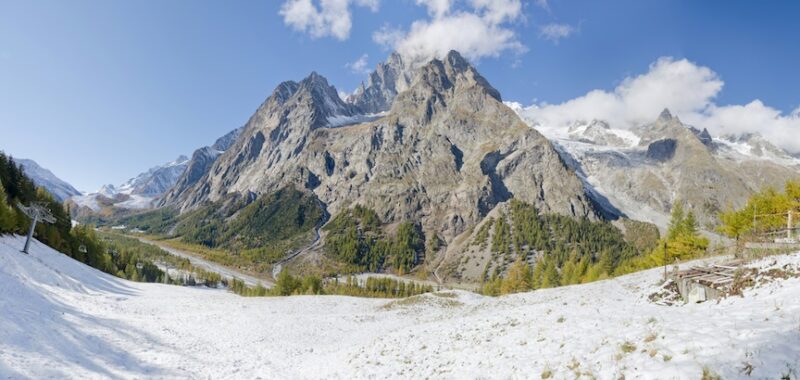In the Middle Ages, the highest peak in the Alps was known as Mont Maudit: the cursed mountain. Today, this same peak is known as Mont Blanc, the “white mountain,” and is the adored subject of alpine postcards and calendar shots.
Behind this transformation in name lies a shift in worldview, according to Kerwin Klein, a professor in UC Berkeley’s Department of History. “Today we think about mountains as beautiful places where we achieve spiritual uplift,” Klein says. “But in the past, mountains were seen as dangerous, unpredictable places. They were landscapes so devilish they killed people.”
In his new book, Steep: A Cultural and Environmental History of Mountaineering (currently in preparation for publication by Oxford University Press), Klein is tracing how the popular perception of mountains went from horrible to serene, a research venture that has taken him across the world, into obscure libraries, and through unexpected detours into other disciplines.
Although he was trained in U.S. history with a focus on the 19th and 20th centuries, Klein traces the roots of modern mountaineering to the European Alps in the late eighteenth century, when mountains were still seen as fearsome, and when scientists were among the first to venture to the highest heights.
In 1787, for example, the naturalist and early earth scientist Horace Bénédicte de Saussure climbed Mont Blanc, an expedition that became a model for applying the scientific method in the field. “Saussure measured everything,” Klein says, noting that the Frenchman published exhaustive lists of barometric pressure, temperature, and even the color of the sky.
Scientists in the late eighteenth and early nineteenth century followed in Saussure’s footsteps, and collectively came to new realizations about the age of the earth and the role of ice in its history. Climbing mountains and writing about rocks and ice intertwined sport with science, and reinforced the growing awareness that the mountains were created by physical forces and laws, and not divine influence. “Mountains were a place where people discovered universal history,” Klein says.
As Klein describes this transition on his blog, “In little more than a century, English travelers forsook descriptions of mountains as warts, pimples, and tumors for rapturous odes to alpine grandeur.”
As the nineteenth century turned into the twentieth, mountains became more accessible. Rail lines and roads turned the Alps and other ranges into sites of middle-class recreation, with only the higher peaks left to glamorous adventurers. Alpine clubs formed in Britain, Germany, Austria, and Italy. These clubs were initially diverse, with Jewish members and socialist branches. But over time, climbing became less about science—the theory of ice ages had become accepted fact, and the study of glaciers had moved to the arctic—and became more “bound up with nationalism, as Alpine clubs became politically powerful,” Klein explains.
In little more than a century, English travelers forsook descriptions of mountains as warts, pimples, and tumors for rapturous odes to alpine grandeur.
By the late nineteenth century, British and German alpinists faced off over challenging climbs around the world, and planting flags at the summits of unclimbed peaks in Africa and Asia played into imperial rivalries. In this era, mountaineers still saw themselves as part of an international elite of sporting, masculine gentlemen. By the 1920s, however, alpine sport increasingly became a nationalistic enterprise, particularly in Germany. By the time the German and Austrian clubs merged in the 1920s, mountaineering in that region had “a base for political anti-Semitism even before the Nazis came to power,” Klein says. In subsequent years, mountaineering films were the westerns of Nazi Germany, and the Alps themselves became deeply political symbols.
Klein’s project traces how, after the war, committed alpinists like Heinrich Harrer (best known as the author of Seven Years in Tibet) rehabilitated the image of German and Austrian climbers, as mountains came to be seen as spiritual places above the human fray. In the decades following World War II, a new generation of enthusiasts came to the mountains because they seemed free from the cares of the world. The mountains were no longer explored to find scientific truth, but to escape it.
“Harrer’s memoir is about climbing as a place without politics,” Klein says. “Instead, the mountains are places that make brotherhood. They’re spiritual escapes…. The Alps have become sacred again, and now the technology [of climbing] has become an instrument for self-actualization. Ice axes, Gore Tex, all this high-tech stuff is about getting to a spiritual place.”
This history of reversals in the view of mountains—from awful to beautiful, from secular to sacred, from political to above politics—took Klein far away from his appointment in modern U.S. history at UC Berkeley, where he delivers lectures and seminars on environmental and intellectual history (including a very popular graduate course on theory and history). His previous publications have focused on how Europeans narrated their encounters with Native Americans, and he wrote an intellectual history of academic vocabularies in the twentieth century.
While alpine history is thus a departure from Klein’s earlier work, it is close to his personal interests. A climber for more than thirty years, the historian’s own passion about mountains and why we climb them came from the practices and community of his fellow mountaineers. “I wanted to write a book my buddies would read,” he says.
For his research, Klein had to learn Italian and Ladin, a language indigenous to the Ladin valley in the Alps, in addition to German and French. With these skills, he could work in the many small libraries that hold old letters, alpine journals, aged dissertations on climbing, and other texts. “Some of the research was very random,” Klein says.
At times, his research went back as far as the late Middle Ages, to the religious traditions of peasants living in the Alps. To understand the meaning of their intricate artwork and its relationship to more modern conceptions of the mountains, Klein pored over tomes on medieval art history. He recollects an encounter with a librarian in Fontainebleau, France. “She was a trained archivist,” he says, “and had this huge collection. I was set up at this 17th-century oak table, looking out at the palace grounds.”
The research has taken most of a decade, and he says that many of the small mountain-town archives he used have been shuttered with Europe’s budget crunch. “I couldn’t write this book now,” he notes. An ironic turn for a book that, in part, uncovers how our understanding of history itself has come down from the mountains.



